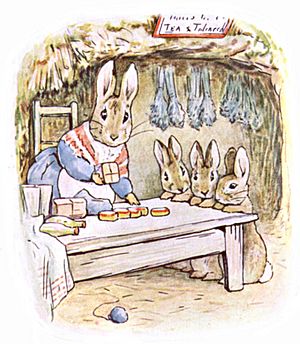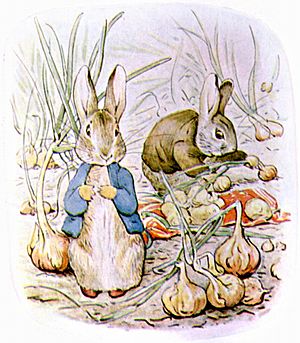The Tale of Benjamin Bunny facts for kids
 |
|
| Author | Beatrix Potter |
|---|---|
| Illustrator | Beatrix Potter |
| Country | England, United Kingdom |
| Language | English |
| Genre | Children's literature |
| Publisher | Frederick Warne & Co. |
|
Publication date
|
September 1904 |
| Media type | Print (hardcover) |
| Preceded by | The Tailor of Gloucester |
| Followed by | The Tale Of Two Bad Mice |
The Tale of Benjamin Bunny is a popular children's book. It was written and illustrated by Beatrix Potter. The book was first published in September 1904 by Frederick Warne & Co. This story is a follow-up to The Tale of Peter Rabbit (1902).
It tells about Peter Rabbit going back to Mr. McGregor's garden. He goes with his cousin, Benjamin Bunny. Their goal is to find the clothes Peter lost there before. In Benjamin Bunny, Beatrix Potter made the rabbit world even bigger. She showed that the rabbit world was like the human world, but complete on its own.
In 1903, Potter and her publisher wanted a simpler book. So, she created Benjamin Bunny as a straightforward story for young children. The amazing pictures in the book were based on gardens at Fawe Park. Potter spent the summer of 1903 at this place in the Lake District. She cared a lot about how her books started and ended. She insisted Benjamin Bunny finish with the words "rabbit-tobacco." This phrase came from the Uncle Remus stories by Joel Chandler Harris. He was one of her favorite writers.
Benjamin Bunny quickly became a big hit. Thousands of copies were sold by the end of 1904. The Times Literary Supplement newspaper praised Potter's "pencil perfect" drawings. Benjamin Bunny later appeared as an adult rabbit in The Flopsy Bunnies and Mr. Tod. In 1992, Benjamin Bunny was made into an episode of the BBC animated TV show, The World of Peter Rabbit and Friends.
Contents
Story of Benjamin Bunny
When Mr. McGregor and his wife leave their home in their carriage, Benjamin Bunny and his cousin Peter Rabbit sneak into Mr. McGregor's garden. They want to get back the clothes Peter lost there in The Tale of Peter Rabbit. They find Peter's blue jacket and brown shoes on a scarecrow. But Peter is nervous about staying in the garden because of his last adventure.
Benjamin slows them down by gathering onions. He wraps them in Peter's handkerchief. He hopes to give them to his aunt, Peter's mother. Then, Benjamin takes a relaxed walk around the garden. Peter follows him, getting more and more worried.
Turning a corner, they see a cat. They quickly hide under a basket. But the cat then sits on top of the basket for five hours. This traps Benjamin and Peter inside. Old Mr. Bunny, Benjamin's father, then enters the garden. He is smoking a pipe and holding a small stick. He knocks the cat off the basket and locks her in the greenhouse. Then he rescues Benjamin and Peter. However, he also punishes the rabbits for going into Mr. McGregor's garden. He whips them with the stick.
Once Peter gets home, he gives the onions to his mother. She forgives his adventure because he got his lost jacket and shoes back. Then Peter and his sister Cottontail fold up the handkerchief. Their mother hangs the onions and rabbit tobacco from the ceiling.
After returning to his garden, Mr. McGregor is confused. He sees tiny footprints, the scarecrow's missing clothes, and his cat locked in the greenhouse.
Inspiration for the Story
In 1901, Beatrix Potter first printed The Tale of Peter Rabbit herself. Then, in 1902, Frederick Warne & Co. published a wider edition. It became very popular. In 1904, she wrote The Tale of Benjamin Bunny as a follow-up. She continued the rabbit stories in 1909 with The Tale of the Flopsy Bunnies and in 1912 with The Tale of Mr. Tod.
All these tales were partly inspired by Joel Chandler Harris's Uncle Remus stories. Potter had even drawn pictures for these stories as early as 1893. She wanted to find a career path. Potter couldn't quite make Harris's characters fit an English garden. But she changed his "lippity-clippity, clippity-lippity" to "lippity-lippity" in Peter Rabbit. She also used his "rabbit tobacco" (which is lavender) in Benjamin Bunny and Mr. Tod.
None of her rabbit characters were based on Harris's Br'er Rabbit. Harris's rabbit wins by being clever. But Potter's Benjamin and Peter often win just by luck. Some experts say that Potter's rabbit world is a nicer place than the one in Harris's stories.
How the Book Was Made
In July 1903, Potter told her publisher, Frederick Warne & Co., that her next book should be simpler. This was after The Tale of Squirrel Nutkin and The Tailor of Gloucester. She had a few story ideas and shared them. She wanted to pick one quickly so she could draw while on holiday. Potter and her publisher decided that Benjamin Bunny would be one of the two books for 1904. Benjamin Bunny had been mentioned in an early version of Peter Rabbit. But he was removed because he wasn't important to that story. A picture of his father was in the private edition, even though he wasn't in the story.
Potter cared a lot about the start and end of her books. She usually avoided common endings. The publisher didn't like the ending of Benjamin Bunny. But she refused to change it to their suggestion of "happily ever after." She felt that ending was "too common" and "not exact." She suggested the last paragraph as it is now. She said, "I would like the book to end with the word 'rabbit-tobacco', it is a rather fine word." She also rewrote other parts, including the scene where Mr. McGregor finds the cat locked in the greenhouse.
While staying at Fawe Park in Keswick, Cumbria with her parents, Potter filled her sketchbook. She drew pictures of the estate's gardens. This included the kitchen garden with its greenhouses and fruit trees. Her father took photos of Fawe Park. Potter likely used these photos to help her draw. The picture of Old Mr. Bunny attacking the cat didn't please her publisher. So, she redrew it. She also redrew the picture of Benjamin and Peter on the garden wall. In Peter Rabbit, Mr. McGregor's garden was in Perthshire. But in Benjamin Bunny, the rabbits and the garden moved to the Lake District. They stayed there for The Tale of Mr. Tod, the last Peter Rabbit book.
During the winter in London, Potter worked on her drawings. By mid-June 1904, Benjamin Bunny was almost done. Many of her sketches from her Fawe Park holiday were used almost exactly in the book. After finishing, Potter said she was glad to be done with the rabbits.
The book was dedicated to "the children of Sawrey from old Mr. Bunny." The start and end of stories were important to Potter. She specifically wanted Benjamin Bunny to end with "rabbit tobacco." This was a term from Uncle Remus that she had made her own.
Twenty thousand copies were printed and released in September 1904. Within a month, more copies were ordered. Another ten thousand were printed by the end of the year. Potter was embarrassed to find that "muffettees" (wrist warmers) was misspelled. This error was not fixed until the third printing.
The Illustrations
Potter borrowed a cat and brought her pet rabbit to Fawe Park to use as models. She was very careful before finishing her drawings. She wrote to her publisher, Warne: "I think I have done every imaginable rabbit background and miscellaneous sketches as well – about seventy! I hope you will like them, though rather scribbled." Even if they were "scribbled," the drawings are very high quality. The sketches of onions and red carnations are great examples. The pictures show her clear love for the simple pots, onions, and flowers in the garden. Many things in the drawings, like the gate, the potting shed, and the wall, have not changed much over the years. You can still recognize them today from her illustrations. Potter knew her story was mostly in colors of fawn, brown, and soft green. She wrote that "the (red) handkerchief will make a good bit of colour all through the book."
Other Appearances and Adaptations
Benjamin became a design on nursery wallpaper. Potter designed this wallpaper soon after the book came out. Benjamin and Peter also appeared briefly in Potter's The Tale of Mrs. Tiggy-Winkle (1905). They returned as adult rabbits in The Tale of the Flopsy Bunnies (1909) and The Tale of Mr. Tod (1912).
In 1992, an animated version of the story was combined with The Tale of Peter Rabbit. It was shown on the BBC anthology series, The World of Peter Rabbit and Friends. Benjamin also appeared in the episodes The Tale of Mr. Tod and The Tale of the Flopsy Bunnies and Mrs. Tittlemouse, along with Peter. In the BBC show, Peter Rabbit's mother's first name is Josephine. In the actual books, her first name is not given. In the CBeebies British and Nick Jr. American computer-animated TV series, Peter Steve Harris voices Benjamin in the US. Danny Price voices him in the UK.
Benjamin appears in the 2018 animated/live-action movie Peter Rabbit. Colin Moody provides his voice. He is a sidekick character in the film.
Royal Doulton sold a porcelain figure of Benjamin's father punishing Peter. This figure was sold from 1975 to 1988.




